您好,登錄后才能下訂單哦!
您好,登錄后才能下訂單哦!
本文小編為大家詳細介紹“python怎么實現圖像自動閾值分割”,內容詳細,步驟清晰,細節處理妥當,希望這篇“python怎么實現圖像自動閾值分割”文章能幫助大家解決疑惑,下面跟著小編的思路慢慢深入,一起來學習新知識吧。
圖像閾值分割是一種廣泛應用的分割技術,利用圖像中要提取的目標區域與其背景在灰度特性上的差異,把圖像看作具有不同灰度級的兩類區域(目標區域和背景區域)的組合,選取一個比較合理的閾值,以確定圖像中每個像素點應該屬于目標區域還是背景區域,從而產生相應的二值圖像。
在skimage庫中,閾值分割的功能是放在filters模塊中。
我們可以手動指定一個閾值,從而來實現分割。也可以讓系統自動生成一個閾值,下面幾種方法就是用來自動生成閾值。
基于Otsu的閾值分割方法,函數調用格式:
skimage.filters.threshold_otsu(image, nbins=256)
參數image是指灰度圖像,返回一個閾值。
from skimage import data,filters
import matplotlib.pyplot as plt
image = data.camera()
thresh = filters.threshold_otsu(image) #返回一個閾值
dst =(image <= thresh)*1.0 #根據閾值進行分割
plt.figure('thresh',figsize=(8,8))
plt.subplot(121)
plt.title('original image')
plt.imshow(image,plt.cm.gray)
plt.subplot(122)
plt.title('binary image')
plt.imshow(dst,plt.cm.gray)
plt.show()返回閾值為87,根據87進行分割得下圖:
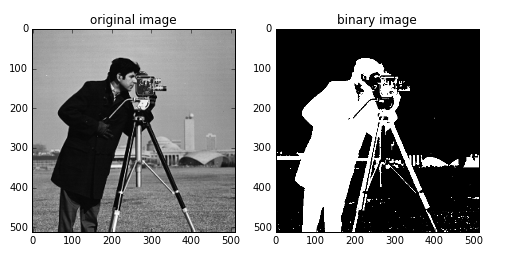
使用方法同上:
thresh = filters.threshold_yen(image)
返回閾值為198,分割如下圖:
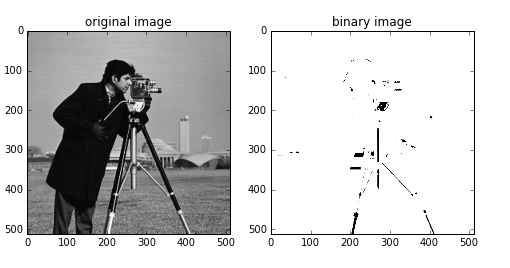
使用方法同上:
thresh = filters.threshold_li(image)
返回閾值64.5,分割如下圖:
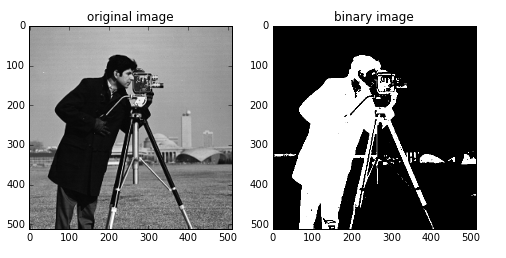
閾值計算方法:
threshold = (image[image <= threshold].mean() +image[image > threshold].mean()) / 2.0
使用方法同上:
thresh = filters.threshold_isodata(image)
返回閾值為87,因此分割效果和threshold_otsu一樣。
調用函數為:
skimage.filters.threshold_adaptive(image, block_size, method='gaussian')
block_size: 塊大小,指當前像素的相鄰區域大小,一般是奇數(如3,5,7。。。)
method: 用來確定自適應閾值的方法,有'mean', 'generic', 'gaussian' 和 'median'。
省略時默認為gaussian
該函數直接訪問一個閾值后的圖像,而不是閾值。
from skimage import data,filters
import matplotlib.pyplot as plt
image = data.camera()
dst =filters.threshold_adaptive(image, 15) #返回一個閾值圖像
plt.figure('thresh',figsize=(8,8))
plt.subplot(121)
plt.title('original image')
plt.imshow(image,plt.cm.gray)
plt.subplot(122)
plt.title('binary image')
plt.imshow(dst,plt.cm.gray)
plt.show()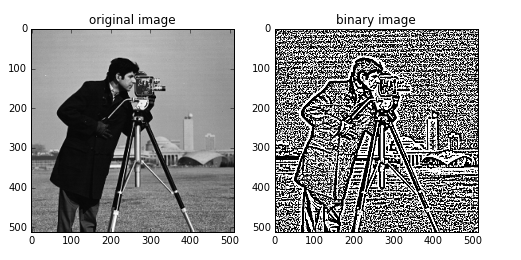
大家可以修改block_size的大小和method值來查看更多的效果。如:
dst1 =filters.threshold_adaptive(image,31,'mean') dst2 =filters.threshold_adaptive(image,5,'median')
兩種效果如下:
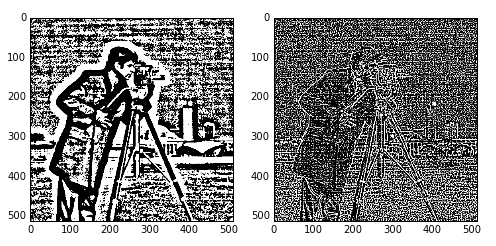
讀到這里,這篇“python怎么實現圖像自動閾值分割”文章已經介紹完畢,想要掌握這篇文章的知識點還需要大家自己動手實踐使用過才能領會,如果想了解更多相關內容的文章,歡迎關注億速云行業資訊頻道。
免責聲明:本站發布的內容(圖片、視頻和文字)以原創、轉載和分享為主,文章觀點不代表本網站立場,如果涉及侵權請聯系站長郵箱:is@yisu.com進行舉報,并提供相關證據,一經查實,將立刻刪除涉嫌侵權內容。